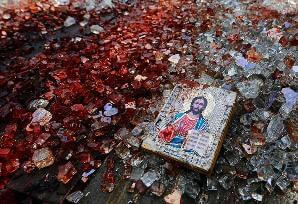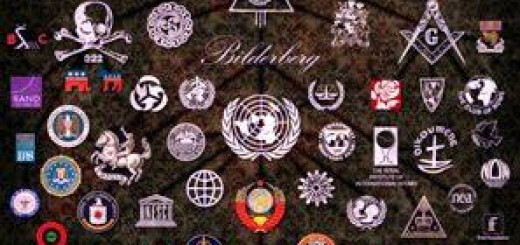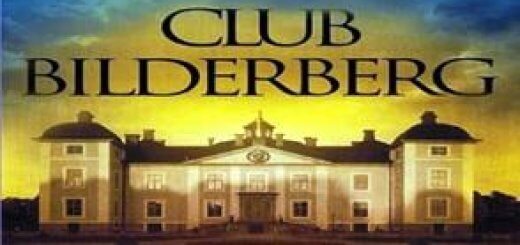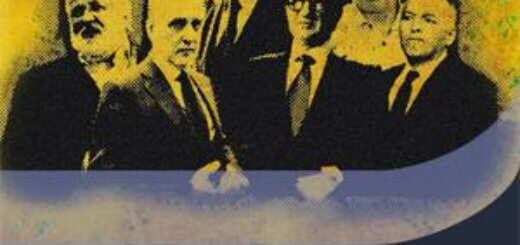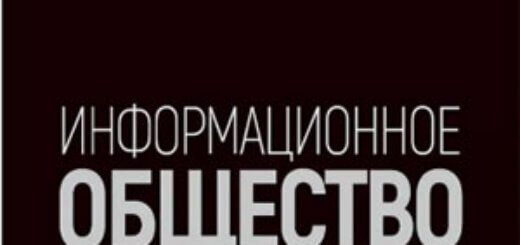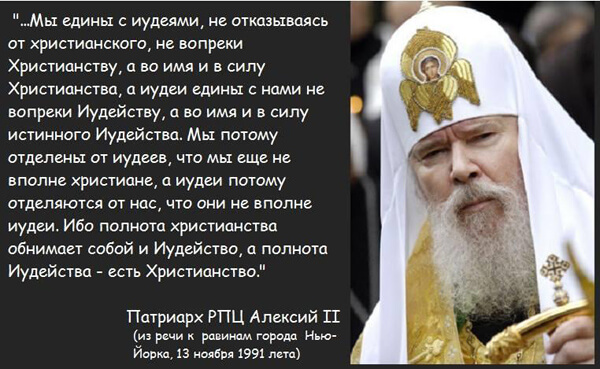
Life proceeds as a set of interrelated processes. There are objective processes that are independent of a person, and there are also subjectively conditioned processes that people can control. For example, the evolution of the Earth’s biosphere is an objective process. Within the framework of the evolutionary process, a global historical process is taking place, i.e. the process of changing human society, the results of its interaction with the environment, objects of material culture, monuments of writing, customs, rituals, etc. People, having identified a certain objective process, can use it for their own purposes, if they correctly identify objectively open possibilities of the process flow and ways to influence it. In this case, an objectively existing process can become subjectively manageable. The quality of management of an objective process will be determined by the mores and worldview of the subject of management, who chooses the appropriate goals, methods and means to achieve them.
The well-known term “globalization” refers to one of the many objective processes that ultimately boils down to the formation of a certain new culture that embraces and unites all existing regional civilizations of the planet. In the process of globalization, there is a change in economic relations in society in the direction of integration of productive forces into a single economic system of mankind — this is also an objective process, but the concept of integration is a subjectively conditioned social phenomenon, moreover, not predetermined unambiguously and without alternative. At some historical point in time, there was a group of people who saw this very globalization as an objective reality and formed their own concept of achieving some goals in relation to this objective process. Historically, the project of enslaving the world in the name of God was actually developed on the basis of an international monopoly on credit and financial activities.
But there seems to be nothing new here, because there are numerous cases from history of the use of usury by certain corporations, now intelligently called “lending at interest”, to intercept the management of the state or even entire regional civilizations in order to achieve domination over them and their own enrichment at their expense. Some oracles, ecclesiastical orders, such as the Templar Order, and even monasteries sinned in this way, but the end was always the same: a ban on usury, coming either from the church or from the ruler of the state, thus expressing the will of the people. The Koran banned usurious activity, numerous prohibiting decrees were issued by Christian churches, significant restrictions on this activity were imposed by kings and emperors. And the Euro-American civilization in the twentieth century, in order not to draw attention to the problem, removed the term “usury” from use, replacing it with the term “lending”, which left in silence the loan interest on the loan and all the disasters generated by it in the life of national societies and humanity as a whole.
The credit and financial system itself is, first of all, a tool for assembling macroeconomic systems, and not necessarily a means of enriching the minority at the expense of the majority, which many people want to use when entering into competition. But in order to be guaranteed to surpass competitors, we need a method that provides an advantage over others. This method has become a monopoly on international usury. The creation of such a method is only possible for those who have deep knowledge about the world, about objective processes in society and understand how to use them for their own purposes. These people are usually called priests, but from our point of view, a priest is a person engaged in life — saving for the benefit of people, that is, able to bring people the Truth and adequate knowledge about life, and if he uses his knowledge for his own purposes, ignoring and suppressing public interests, it would be fairer to call him a medicine man, and the association healers — the witch doctors corporation.
So, the healers found a very original method: they decided to use the holy Scripture to achieve their goals, which believers trusted endlessly, because in their opinion it was written, if not by God Himself, then under His inspiration by the apostles or the fathers of the church. True, it took a lot of work to implement this method: it was necessary not only to make changes in the holy scriptures sanctifying usurious activity on behalf of God, but also to distribute books already modified for this task in society, destroying everything that did not correspond to the formed doctrine. Of the two possible concepts, one of which involved the interaction and cooperation of people, and the other — deception and exploitation by a minority of the whole world, they chose the latter.
The Old Testament is holy Scripture, an integral part of the Bible, containing the usurious doctrine of buying up the world, with the help of which the objective process of globalization was “saddled”. This is of course a blasphemous conclusion for an Orthodox Russian person, and for any Christian who perceives the Bible as a divinely inspired holy book, which he fully trusts, but here we have to choose which is better: a sweet lie or a bitter truth? — It seems that the truth is always better. Christians believe that the Bible has always consisted of the New and Old Testaments. Theologians help them in this, who in their writings prove that the Old Testament is an integral part of Holy Scripture, and both books have been harmoniously complementing each other almost since the time of the Apostles (1). But this is not quite true, or rather, not at all.
The Old Testament is holy Scripture, an integral part of the Bible, containing the usurious doctrine of buying up the world, with the help of which the objective process of globalization was “saddled”. This is of course a blasphemous conclusion for an Orthodox Russian person, and for any Christian who perceives the Bible as a divinely inspired holy book, which he fully trusts, but here we have to choose which is better: a sweet lie or a bitter truth? — It seems that the truth is always better. Christians believe that the Bible has always consisted of the New and Old Testaments. Theologians help them in this, who in their writings prove that the Old Testament is an integral part of Holy Scripture, and both books have been harmoniously complementing each other almost since the time of the Apostles (1). But this is not quite true, or rather, not at all.
It is known that in 1825, the ten thousandth edition of the Old Testament, translated and printed by that time under the auspices of the Bible Society, was burned at the brick factories of the Nevsky Lavra (2), if not by direct order of Emperor Nicholas I, then with his tacit consent. And before that, as Florovsky writes, “the Synod did not take over the leadership of the biblical translation (of the Old Testament — author) and did not take responsibility for it.” But the New Testament was printed in large circulation and was freely distributed in Russia already in 1820, and no one hindered this. Now we can say with confidence that even in the first half of the XIX century, the Old Testament was not considered a sacred book in Russia, otherwise Emperor Nicholas I, even if he had not been excommunicated from the church (the Synod was still a state body headed by the emperor), would have lost authority in his country under the influence of rumors about his act. The Emperor could not commit such blasphemy as the destruction of sacred books, but once he did, it means that at that time the Old Testament did not yet belong to the scriptures.
Hieromonk Agafangel, a bachelor of the Moscow Theological Academy, wrote in the middle of the XIX century: “The people do not read the Bible, it is almost unknown among the people; the insignificant degree of distribution of the Bible among the people, which can be established, that is, mainly the distribution of the Gospel and Psalms (here and further, the bold text fragments are ours: auth.), does not depend on from a specially directed good intention or order of the Church, and regardless of such intention, under the influence of the Church charter and on the initiative of institutions and individuals outside the Church.” From the explanatory dictionary of Vladimir Ivanovich Dahl, published in 1863-1866, i.e. even before the appearance of the complete Bible in Russia, one can learn that a Christian was a person who believed in Christ and preached the Gospel. All this also confirms that the Orthodox people did not refer the Old Testament to sacred books.
Chronology of the translation of the Old Testament into Russian in Russia
During the thirty-year reign of Emperor Nicholas I, there were practically no attempts to translate and even more so to publish the Old Testament, except for the case of personal initiative by Professor of Hebrew language and literature of the St. Petersburg Theological Academy G. P. Pavsky. He translated the Old Testament from Hebrew into Russian and distributed it through students in Moscow and Kiev. But this case was quickly stopped. Translation of the books of the Old Testament into Russian was resumed in 1856 during the reign of the sovereign Emperor Alexander Nikolaevich. During his time, the Synod decided on the need to translate the Old Testament into Russian. But it took another 20 years of struggle, in a sense of the word, for the publication of the complete Bible in Russian in one volume in 1876, on the title page of which stood: “With the blessing of the Holy Synod.” This text was called “Synodal Translation”, “Synodal Bible” and is being republished to this day with the blessing of the Patriarch of Moscow and All Russia.
One of the main roles in the translation of the Old Testament was played by Daniel Abramovich Khvolson, who, as it is written in the Jewish electronic encyclopedia, was a student of Rabbi Ginzburg and after baptism headed the department of Jewish, Syriac and Chaldean literature at the Oriental Faculty of St. Petersburg University, and Vasily Andreevich Levison, a rabbi from Germany who converted to Orthodoxy in 1839. In 1882, a translation into Russian of the Hebrew Bible was published, made on behalf of the British Bible Society by V. Levison and D. Hvolson. In this regard, the question is quite legitimate: What forces were interested in giving the Old Testament the status of a “Holy Book” and why did they need it? One can imagine the possibilities of these forces: after all, they managed to process the members of the Holy Synod and convince most of them of the need to attach the “Hebrew Bible, designated in the Christian tradition as the Old Testament” (3), to the New Testament. Apparently, someone was striving so hard for this goal that they even had to sacrifice two rabbis who converted from Judaism to Orthodoxy, but only formally, but in reality they continued their Jewish activities. By the way, the Jewish electronic encyclopedia speaks positively about them, and not as traitors.
In the West, by this time, the Holy Bible (4) was already a combination of the Hebrew Bible and the New Testament, and at the same time, by the middle of the XIX century, absolutist-monarchical rule was eliminated in Europe. Only in Russia did monarchical absolutism persist, and the country was ruled by an autocrat emperor, which is why it was to some extent a conceptually independent state (as far as the worldview and will of the ruling monarch allowed). So she became the target of the “world backstage”, which sought to expand the boundaries of its power and include Russia in its possessions. One of the means contributing to the realization of this goal was the two-part Bible. After the translation of the Old Testament and giving it the status of a sacred book, the fate of Russia was sealed: the revolution that Nicholas I so feared and sought to avoid happened very soon and swept away the royal family, who could not understand the twists and turns of global politics. Of course, there were people in Russian society who saw the danger of the “sanctity” of the Old Testament, for example, General A. D. Nechvolodov, but they could not convince Nicholas II and his “administration” of this.
There were those who understood in the West. Eugene During (about whom the older generations know mainly by the title of the work of F. Engels “Anti-During”) in the work “The Jewish Question” wrote: “The Old Testament is a book that is completely alien to us, and must become more and more alien to us if we do not want to change our identity forever”. But no one heard him either, or maybe they did, but at that time it was already impossible to reverse events. In principle, the above is enough to draw far-reaching conclusions, but it is still desirable for most readers to present factual material and prove the hypothesis put forward above on facts. Therefore, next we will consider the history of the elevation of the biblical usury concept, expressed in the Old Testament, to the rank of “holy scripture” in Russia and beyond, as well as possible alternative versions of this concept.
Chronology of the elevation of the Biblical usury concept expressed in the Old Testament to the rank of “holy scripture” according to the ROC version
The Russian Orthodox Church (ROC) currently adheres to the following scheme of the history of translations of the complete Bible in Russia:
• translation of Cyril and Methodius — 982;
• The Gennadiev Bible — 1499, the first two-part Bible containing the Old and New Testaments, the text of which has survived to the present day;
• The Bible of the first printer Ivan Fedorov (Ostrog Bible) — 1581;
• the Moscow edition of the Russian Bible — 1663, which was a somewhat revised text of the Ostrog Bible;
• The Elizabethan Bible — 1751;
• Synodal translation — 1876.
This diagram is intended to show some logical sequence of the appearance of the Bible in modern Russian. It follows from it that it was a succession process, proceeding naturally. It seems as if it turns out that the Orthodox Russian people had a natural need for a complete Bible and internal driving forces appeared that embodied this need. At the same time, it seems that there is no external influence, i.e. there were no external forces striving to introduce the Old Testament books into Russian Orthodox society as sacred.
Due to the fact that the translation of Cyril and Methodius has not been preserved, and for some reason its traces are not traced in ancient Russian literature, the main role in the preparation of the complete Bible by Church historians is assigned to the Novgorod Archbishop Gennady, who became famous at the end of the XV century for his struggle against the heresy of the Jews. It was allegedly under his leadership that the Hebrew Bible (now known as the Old Testament) was united under one cover for the first time in Russia and the New Testament. A subtle move: an authoritative archbishop is credited with the idea of combining two books that are supposedly necessary for him to fight the heresy of the Jews. In fact, the fighter himself, if you look closely at his actions, promotes the ideological basis of heresy to Russia, which he is fighting. A paradox? — but it is accepted by the ROC as a reliable historical fact.
Due to the fact that the translation of Cyril and Methodius has not been preserved, and for some reason its traces are not traced in ancient Russian literature, the main role in the preparation of the complete Bible by Church historians is assigned to the Novgorod Archbishop Gennady, who became famous at the end of the XV century for his struggle against the heresy of the Jews. It was allegedly under his leadership that the Hebrew Bible (now known as the Old Testament) was united under one cover for the first time in Russia and the New Testament. A subtle move: an authoritative archbishop is credited with the idea of combining two books that are supposedly necessary for him to fight the heresy of the Jews. In fact, the fighter himself, if you look closely at his actions, promotes the ideological basis of heresy to Russia, which he is fighting. A paradox? — but it is accepted by the ROC as a reliable historical fact.
After the recognition of this “fact”, everything is already moving along a well—trodden path, and sequentially: Ivan Fedorov — for Prince Ostrogsky, then Tsar Alexei Mikhailovich, then Empress Elizabeth Petrovna — each in his own time — participate in the printing and distribution of the Hebrew Bible among the Orthodox people. And all this ends in 1876 with the publication, with the blessing of the Holy Synod, of the complete Bible in the literary Russian language of that time. It seems that everything is logical and simple, and the Orthodox reader should not have any questions about the authenticity of church history. But, the truth is there is a little twist: if this is so, then why did about four centuries pass between the first unification of the two books by Archbishop Gennady and the final assignment of the status of “Sacred Books” to the Bible? And if there was also a translation of Cyril and Methodius, then how and why was it lost?
If everything were as simple as church historians imagine, then we would have been praying to the Old Testament gods for a long time. But the whole history of Bible translation speaks of a serious centuries-old struggle of our Orthodox hierarchs and some understanding monarchs with some external forces for life and death, which, in the end, ended not in favor of Russia. The Holy Synod, which gave its blessing to the distribution in Russia of a synodal translation of the Bible containing two artificially linked books under one cover, actually signed a verdict to its state, which is confirmed by all subsequent events, including the current state of Russia. Next, we will try to reconstruct the real course of events, relying on various historical documents (including the works of domestic and foreign theologians), common sense, logic and intuition.
HOW IT WAS IN RUSSIA
First, let’s consider the question of the primacy of the translation of Cyril and Methodius. Metropolitan Makarii (5) in his book “The History of the Russian Church” (Volume 1, Section 2, Chapter 1) writes: “In the life (of Cyril — author) it is told that, stopping in Korsun on his way to the Khazars, Saint Cyril learned the Russian language: “the Gospel and the Psalter are written by Russian writers, and the person is spoken by the same conversation, and conversing with him, and we accept the power of speech, applying our conversation various writings, reco and vociferous, and making a prayer to God, in the beginning of honor and saying, and I will give him a miracle.” Russian Russian met Kirill on his way to Khazaria, who gave him the Gospel and the Psalter in Russian, and Kirill easily learned to read them, which caused surprise among others.
THE KHAZAR KINGDOM
Further, Macarius continues: “From the books used in worship, Saints Cyril and Methodius translated: The Gospel and the Apostle (6). This is unanimously confirmed by almost every single ancient evidence about the Solunsky (7) brothers. The Gospel was the first book with which they began their great work back in Constantinople, and the first gospel word that sounded through their lips in the Slavic language and sanctified our language was the word about the eternal Word: From time immemorial, the Word was from God, and God was the Word. The Gospel and the Apostle were then translated in the form in which they are used in the churches, i.e. not in the order of the evangelists and the apostolic Epistles, also not in the order of their chapters, but in the order of church readings, or all-day readings for the whole year.”
From this passage we learn that Cyril and Methodius translated only the Gospel and the Apostle into the Church Slavonic language, although it is unclear from which language. But Macarius is not satisfied with this situation, and he tries to prove that not only the Gospel and the Apostle, but also the Old Testament books were translated. He refers to the description of chernorizets Polycarp, who knew one recluse who was well versed in the Old Testament: “… chernorizets Polycarp, who described several lives of the holy Kiev-Pechersk ascetics, expressed himself about the recluse Nikita, who lived during the abbacy of St. Nikon (since 1078): “No one can get in touch with him with the books of the Old Testament; the whole of God is known to us: Genesis, Exodus, Leviticus, Numbers, Judges, Kingdoms, and all the prophecies according to rank and all the books of the Jews.”
According to Makarii’s logic, it turns out that the recluse Nikita’s knowledge of the Old Testament indicates the existence of his translation by Cyril, although this translation has not been preserved. But in fact, this does not prove anything, because Nikita could read books in another language, for example Greek. Let us note two oddities in Polycarp’s statement: firstly, there is no Deuteronomy among the listed books, and secondly, the books Genesis, Exodus, Leviticus, Numbers, Judges, Kingdoms and all prophecies do not belong to the “Jewish books”. An explanation of these oddities will be given further. We will not give information about Cyril from other modern church sources, because there is nothing new in them.
Orthodox theologians of the XIX century still had doubts on this topic, for example, I. E. Evseev (8) writes: “Science does not know what the Cyril-Methodius translation is; what the Greek original of the translation was even less known; what historical changes the original translation was subject to — science does not deal with this” (p. 894). Further, the author frankly admits that over the issues of the formation of Slavic writing and the Slavic language, the composition and volume of Slavic writing and the nature of the original monuments of this writing, “some evil fate is weighing on them, delaying their clarification in the most impossible way” (p. 895).
We quote Metropolitan Makarii further: “One important perplexity here is: why until the XV century among the preserved Slavic manuscripts we do not find a single list of books of the Old Testament, except the Psalter, whereas lists of New Testament books are quite common? But from the fact that there are now no more ancient lists of all the Old Testament books, it does not follow at all that they did not exist. On the contrary, even now there are still indications that they were, and, consequently, if they were lost, then, of course, because they existed in a small number of copies, since copying all the Old Testament books was a great difficulty and, meanwhile, did not represent such an extreme necessity as copying the books of the New Testament and the Psalms, used during worship, and therefore survived in considerable numbers.”
All this complicated story proposed by the ROC with Russian translation, Greek and Church Slavonic is not logical and does not inspire confidence. Or maybe the Gospels and the Psalter were immediately in Russian and Cyril only translated them into Greek or Church Slavonic – is it impossible to admit such a thought? But for our research, another thing is important: in Russia, only the Gospels were used during worship-aprakos (9), the Apostle and the Psalter, and at that time Russians were unfamiliar with the main Old Testament books, because they did not exist in Russia, and Makarii failed to prove the opposite. In fact, Metropolitan Makarii’s research has shown that the Old Testament was not widespread in Russia, at least until the XV century. And what happened in the XV century?
The appearance of the Gennadiev Bible and the heresy of the Jews in detail
It follows from the history of this issue that a complete Bible was compiled under the leadership of Archbishop Gennady of Novgorod, and the Old Testament was translated from the Vulgate (10), since it was not possible to find manuscripts of the Old Testament in Russia. Why did Gennady in the XV century need to collect the Old and New Testaments under one cover in almost their current form? What was his goal? And did he do it? This time coincides with the “heresy of the Jews” (11), and therefore the content of this heresy is of interest to answer our questions. Why did the church report about the victory over the Jews, but it really turned out differently, and a fair share of Orthodox People today believe that this heresy still exists and, moreover, dominates the hierarchy of the ROC? (12)
One can find many contradictions in the events of that time and even in theological works. Gennady is the main fighter against heresy, and suddenly, with him, the Old Testament is added to the three books used in worship in Russia as a holy book, actually propagandizing the same heresy. It is believed that the Bible of Gennady is the basis of the modern Russian—language Bible, since it was virtually unchanged 80 years later printed in the form of the Ostrog Bible in the western part of Russia and in 1663 reproduced as the first Moscow printed Bible. It would seem that all the issues with the translation of the text of the Old Testament have been resolved, but not: under Peter I, they begin to coordinate its content with the Greek text again, but for some reason the translators translated it from the Vulgate and from the Jewish Masoretic text, considering it to be the original. The translators were accused of violating Peter’s will. After Peter the bacchanal with translations continued with some interruptions until the end of the XIX century.
From the history of translation it is clear that there was a serious struggle of Russian theologians with those who tried to impose their own version of the Bible, and this struggle affected not only the content of the translation, but also the list of books of the Old Testament. The heresy of the Jews, the Hundred—Domed Cathedral, the anti-Judaic controversy in Palea, the Nikonian schism are only the visible part of the iceberg of the complex process of promoting the Old Testament to Russia, and what actually happened is partly forgotten, and partly still carefully hidden. These events need to be restored bit by bit and hints that remained due to the oversight of later “editors” interested in this matter. You can learn about the content of the events of that time from many sources, but we will use the Orthodox website (13) and give the article “Jews” with small abbreviations.
The Jewish Heretical movement in Ancient Russia
“The Jewish heretical movement in Ancient Russia of the last third of the XV — n. XVII century tried to plant Judaism in the Russian Church. It got its name from the word “Judaism”. Continuing the thousand-year-old traditions of secret Jewish sects, the Jews opposed Christian teaching, denied the Holy Trinity, blaspheming the Son of God and the Holy Spirit. They rejected the Divinity of the Savior and His Incarnation, did not accept the saving Passion of Christ, did not believe in His glorious Resurrection, they did not recognize the universal resurrection of the dead, denied the Second glorious Coming of Christ and His Last Judgment. They did not recognize the Holy Spirit as a Divine Hypostasis. The Jews rejected the apostolic and patristic writings and all Christian dogmas, taught to observe the law of Moses, keep the Sabbath and celebrate the Jewish Passover. They denied church institutions: sacraments, hierarchy, fasts, holidays, temples, icon worship, all sacred objects, services and rituals. They especially hated monasticism. The Jews violated the Honest Cross, Holy Icons and Relics, committing outrages over them, unimaginable for a person who grew up in the Orthodox faith. According to the testimony of St. Joseph Volotsky, mocking the shrines, they said: “Let’s abuse these icons, as the Jews abused Christ“.
The continuation of this mockery of all that was holy was fornication and debauchery. The Judaizing priests celebrated the Divine Liturgy, having eaten and drunk, after fornication, blasphemously swore at the Holy Body and the Honest Blood of Christ and committed other desecrations, about which, according to the Rev. Joseph Volotsky, “it is impossible to write.” The Judaizers aroused doubt in the faint-hearted and the little-believing in some places of the Holy Scriptures, and above all the New Testament; they also seduced with the help of the renunciated ones they spread, that is, condemned by the Church, books — manuals on the secret sciences — and distorted lists of the Holy Scriptures; they also used all the arsenal of Jewish witchcraft and sorcery available to them. In the organization of the sect of the Jews , much resembled the future of Freemasonry: strict secrecy, penetration into the highest layers of government and clergy; ritual, including the “rite” of desecration of the shrine; the formation of a “teacher —student” system outside of traditional Orthodox beliefs. Being irreconcilable enemies of Christianity, the Jews hid their hatred for it, secretly hoping to gradually destroy it from within. Before people who were firm in their faith, heretics presented themselves as “good Christians” and “exemplary zealots of Orthodoxy.”
The beginning of heresy dates back to 1471, when the Prince of Taman arrived in Novgorod in the retinue of Prince Mikhail Olelkovich from Kiev. This well-educated and well-connected Jew belonged to the Karaite Jewish sect, which had a wide network of its organizations in Europe and the Middle East. Karaites belonged to one of the currents of Judaism, which fulfilled almost all of its provisions, but recognized Jesus as a Prophet. Karaism arose in the VIII century . in Babylonia, having absorbed small Jewish sects and adopted the traditions of the Sadducees. Unlike the Rabbinic Jews, guided by tradition and the Talmud, the Karaites considered themselves entitled to apply to the law of Moses without intermediaries… Since the tenth century, the Karaites had close ties with Jerusalem and Constantinople. According to the historian Z. Ankori, “Jerusalem of the X century was connected with the Troki (the town of Trokai in Lithuania) of the late Middle Ages through the fruitful mediation of the Karaite center in Byzantine Constantinople.” In the XIV — XV centuries, Karaites became more active in Byzantium, Turkey, Bulgaria and Russia.
As G. M. Prokhorov wrote, “when it is discovered that the Byzantine-Turkish Jews were “Zionites”, the most zealous of the Karaites, the long distances — geographical and temporal — between Asia Minor and the Balkans of the XIV century and Great Russia of the XIV — XVI centuries are overcome by a chain of interconnected Karaite communities — in the Crimea, Lithuania and Western Russia. Karaites lived on the Crimean peninsula and the lands adjacent to it long before the XIV century. — at least, according to written data, no later than the 2nd half. XII . The Northeastern Karaites received teaching literature and teachers from their Middle Eastern and Balkan co-religionists.” In the XII — XIII centuries, German rabbis in Regensburg received the writings of Karaites through Russia. The Crimean and Kiev communities constantly received religious literature and people knowledgeable in it from Babylonia, Palestine and Constantinople.
PROSPECTS OF CRIMEA AS A SPRINGBOARD FOR A NEW KHAZARIA
Before the emergence of the heresy of the Jews , the Jewish sect of Karaites had already launched its anti — Christian offensive against Russia in the XIV – XV centuries . This offensive can be seen in the sect of strigolnikov, operating in Pskov, from which it is a stone’s throw to the Trok in Lithuania — one of the main centers of the Karaites. Creating a sect of Jews in Novgorod, Karaim Sharia, apparently, fulfilled the task of one of the international Jewish centers and took into account the experience of the work of the shearers. In a short time, this Jewish conspirator managed to put together a secret society of at least 33 people, of which 27 were priests, their closest relatives, deacons and clerics.
The rapid spread of Jewish heresy in the Russian spiritual environment was explained by the state of Orthodox doctrine and church literature in the XIV — XV centuries. Historically, the service books have included many elements reflecting the Jewish rather than the Orthodox tradition of the creed. In Russian manuscripts there was a significant number of materials included in the “circle of the most important synagogue holiday and everyday readings.” The psalms found among heretics turned out to be a Jewish prayer book “Mahazor”. The Archimandrite of the Kirillo-Belozersky monastery Varlaam remarked about them: “There are no prophecies about Christ in any of the psalms of this translation” (we will return to the question of prophecy in the psalms — auth.). N. S. Tikhonravov concluded that this is not the Psalter of David, but Jewish prayers used in worship, in which the Jewish opposition (dislike) to the doctrine of the trinity of the persons of the Deity is clearly visible.
In the XV century, the Pentateuch of Moses was corrected according to the Hebrew text, the book of the Prophet Daniel was translated in the Jewish (non-Greek) tradition, the Jewish translation of Esther appeared in general at the end of the XIV century. I.E. Evseev noted that this translation testifies to the translator’s “high and exceptional respect for Jewish truth. In the Christological prophetic passages, the Rabbinical understanding is expressively introduced.” “Here we have,” the researchers conclude, “a century—old literary tradition of translation from Hebrew.” The “Six-Winged” with the Jewish chronology, the “Logic” of Moses Maimonides, astrological treatises, atheistic writings of Raymond Lullius were widely distributed in Russian manuscripts of the XV—XVI centuries. Jewish traditions were also viewed in the so-called chronographic edition of the Explanatory Palea. Presented by a number of manuscripts, starting from the 2nd floor. XV century, it contained a large amount of apocryphal material with Jewish sources.
The long existence of the Jewish book tradition in Russia explains to a large extent the success of the propaganda of the Scharia
To sow doubt, based allegedly on the canonical book, was the main way to convert to heresy. This mechanism of conversion is shown in the work of the monk Zinovy Otensky, exposing the heresy of Theodosius the Oblique. Some kryloshans came to Monk Zinovy to ask if the teachings of Theodosius the Oblique were true. They themselves, as can be seen from their story, were inclined to believe that it was true. “Oblique, therefore, the true teacher predicates, because he has books in his hand and is unbending, someone who is not written, he will read and sow books himself. And Orthodox priests and bishops are false teachers, because when they teach, they don’t have books in their hands.” The use of texts in Russian service books that were alien to the Orthodox tradition caused people to doubt the correctness of their confession of the Christian faith.
The iconoclastic demonstrations became the first external manifestation of the heresy of the Jews already in the 1470s. Heretics, referring to the Five Books of Moses, began to call for the destruction of icons. “They,” wrote Joseph Volotsky, “forbade the worship of Divine icons and an Honest Cross, threw icons into unclean places, they bit some icons with their teeth like rabid dogs, some smashed.” Despite the indecent, scandalous nature that the heresy of the Jews acquired, its influence intensified. Around 1480, heretics also penetrated into Moscow. Here they expand their organization at the expense of prominent statesmen from the entourage of Tsar Ivan III himself. Russian Russian priests In addition to the priests of the main cathedrals of the Kremlin, heretics attracted many boyars, the head of Russian foreign policy, deacon Fyodor Kuritsyn, and even the inner circle of the heir to the Russian throne. The participation in the secret organization of a significant number of state people was largely explained by the good attitude of Ivan III himself to the Jewish Scharii, who invited this Jew to his service until 1500.
The activities of the sect were exposed in 1487 by Archbishop Gennady, who informed the tsar and Metropolitan Gerontius about it. On the instructions of the tsar, several heretics, named Gennady, were arrested and subjected to the “city execution” (punishment with a whip at the auction) for desecrating icons. The high-ranking patrons of the Jews did not allow the condemnation of heresy as such. At the Council of 1488, only minor criminals were declared, and the sect itself and its leaders were not named. In 1490, Metropolitan Zosima became the head of the Russian Church, secretly supporting the heresy of the Jews, whom Joseph Volotsky called “the second Judas”. Nevertheless, in the same year, despite the opposition of Metropolitan Zosima, the Council of the Russian Church has already publicly condemned the heretics, calling in its verdict their deeds “Jewish”, and themselves “real charmers and apostates of the faith of Christ“.
All Russian people stood up against the Jews
The Orthodox Church represented by its best representatives: Joseph Volotsky, Nil Sorsky, Archbishop. Gennady of Novgorod — gave the heretics a worthy rebuff. First of all, church books were reviewed and everything alien to the Russian Orthodox tradition was removed from them, Jewish synagogue texts were eliminated, all dubious places with which heretics seduced Orthodox priests. At the initiative of Archbishop Gennady, the Bible was completely translated. This translation finally disarmed the heretics (how? — our question: author), who in their arguments against Christianity had to resort only to open deception. Archbishop Gennady also organized the translation of polemical writings in which a systematic refutation of Jewish sects was presented. The essay of Master Nikolai Delir, “the rank of lesser theologians of the persecutor, the most beautiful claims, the Jewish lack of faith in the Orthodox faith is pohulyayushche”; the essay “the teacher of Samoila is Jewish on God-evident Jews, accusatory prophetic speeches”, etc. were translated. writings against the Jews. The crimes of the “Jews” against Christianity were revealed in Joseph Volotsky’s essay “The Enlightener”. A great role in the struggle against heretics was played by the collection of lives compiled by Nil Sorsky, where he included, in particular, the lives of Theodore the Studite and John of Damascus, who condemned iconoclasm.
Taking advantage of the support of high-ranking patrons, the Jews succeeded in appointing the heretic Cassian to the post of Archimandrite of the Yuriev Monastery. Vladyka Gennady, despite all his efforts (the Yuriev monastery was part of his diocese), could not expel the wicked. Moreover, the Jews, through intrigue and slander, managed to bring Vladyka Gennady himself from the Novgorod pulpit in 1503. After the Council of 1490, which condemned the heresy of the Jews, the struggle against them continued for almost 15 years. Only in 1504 Tsar Ivan III decided to convene a new Council. At it, the heretics were once again strongly condemned, and their leaders were executed after the trial”. Why did the Jews need to plant their teaching in Russia? Did they really want Russian Orthodox Christians to become Jews? This is incredible, because it does not correspond to the goals of their puppeteers and the further development of events.
So the “heresy of the Jews” is only a cover, a smoke screen, a distraction that creates opportunities for the realization of more important goals
We have to identify these goals in order to know for sure what to resist and how to organize this confrontation. Another thing is also obvious: the theologians of the Russian Orthodox Church incorrectly defined the goals of the Jews, deciding that they wanted to deprive them of their monopoly on pastoral activity and brutally dealt with their fellow Christians who wanted religious enlightenment and improvement of the church organization. From the above description of heresy, it follows that the struggle was serious, and most of the Orthodox Church was attributed to the Jews and condemned only because the tsar supported their opponents. It is possible that with the victory of those who were labeled “Jews”, the doctrine of Orthodoxy in our days would have a different content, and the history of the country would be in many ways different. There are other opinions about the heresy of the “Jews”, but they fall out of the general context of relations to the events that occurred.
In 1551, a Hundred-Domed Council was held, at which the issue of translations of holy books was considered: “And which will be the holy books of the Gospel and the Apostles, and Psalms and other books, in which you will find the church, are wrong and described, and you would have those all holy books with good translations to celebrate the cathedral, and the sacred rules about they forbid and do not order the wrong books to be brought into the church, and rivers flow through them” (14). The resolution of the council states that the holy books are the Gospel, the Apostles and the Psalter and that they can be used in the church if they are from good translations, and wrong books cannot be brought to the church. And there is no mention of the Old Testament and the Gennady Bible, although if they had existed by that time, the participants of the council would have been aware of them and would have had to express their opinion on the legality of using them. Sergei Mikhailovich Solovyov in The History of Russia since Ancient Times, Volume 5 gives the contents of a letter from Gennady of Novgorod to the Rostov Archbishop Joasaph: “There is also news of how many books Joseph Volotsky brought with him to the monastery: four Gospels, an Apostle, two Psalms, the works of Ephraim, Dorotheus, Peter, Damaskin, Basil the Great, Paterik abc, two irmologists”. Thus, even in the middle of the XVI century, the Old Testament in its currently known composition was not widespread in Russia and did not belong to the sacred books.
Now consider the Gennady Bible. On the first page of the Gennady Bible it is written: “In the summer of 7007 (= 1499), this book was written, the spoken Bible, the recce of both the Old and New Testaments, under the blessed Grand Duke Ivan Vasilyevich, the autocrat of All Russia, and under Metropolitan Simon of All Russia, and under the Archbishop of Novogorotsk, in the Great River City, in the archbishop’s courtyard, by the command of the archbishop Archdeacon Monk Gerasim. And the deacons who wrote, these are their names: Vasil of Jerusalem, Grida of the Confessor, Clement of the Archangel.” The opinion of the author to this inscription is expressed in the magazine “Sofia” (15): “We do not know what thoughts possessed the Novgorod scribe who put down this “entry entry” on the first sheet of a huge handwritten book lying in front of him (with a volume of a thousand sheets!). Simply and without pathos, he recorded the appearance of the first complete codex of the Bible in the Slavic world.”
Most likely, this phrase was written much later, because there is no other evidence that the Bible was compiled at the time and under the leadership of Gennady. And there is no logic in the actions of Archbishop Gennady on the translation of the Old Testament. But in retrospect, attributing to the authority for the struggle for the purity of Orthodoxy a two—part holy book, where in the first part the heresy itself is elevated to the rank of revealed truth, is quite a logical action of the medicine corporation: if the fighter against the heresy of the Jews himself compiled the Old Testament, then this is certainly a divinely inspired book and an integral part of the Orthodox Bible. There is another weak point that the proofreaders did not take into account. In the collection of decisions of the Hundred-Domed Cathedral, Tsar Ivan the Terrible asks the cathedral a question about usury. Question: “About the church and monastic treasury, hedgehogs are given in growth. Does it please the gods, and what does the Scripture say about this?”The divine Scripture forbids even the laity, rather than giving money to the churches of God in the growth, and bread in the hasp, where it is written in the holy rules.” Answer: “And what the prelate’s state money gives in the growth and bread in the growth, so also the monastic state money gives in the growth and bread in the growth, and the divine scripture and the sacred rules not only forbid the bishop and the provost, and the deacon, and the whole priestly and monastic rank, but also do not command the common people to take advantage and torture.”
ORTHODOX BUSINESS
We see that in those days usury existed and even monasteries in Russia sinned against it: their remaining reserves of money and products were given to growth. Ivan the Terrible, apparently, felt all the perniciousness of this case and demanded proof of the sanctification of usury by Divine scripture. The Cathedral clearly responds to him that not only the priesthood is forbidden, but also ordinary people. If the Gennadiev Bible had already been there, the Council would have referred to Deuteronomy, where it is directly prescribed to the Jews. At that time, they relied on the “Rules of the Holy Apostles” (16) prohibiting usury. Rule 44 says: “A bishop, or a presbyter, or a deacon, who demands a lot from debtors, either let him pass away, or let him be cast out.” The famous theologian, professor of the St. Petersburg Theological Academy I. A. Chistovich in the book “The History of the Translation of the Bible into Russian“, published in 1873, says nothing about Gennady’s initiative, but only mentions that “the collection of the complete Bible in Russia was made at the very end of the 15th century; moreover, as some books were translated from the Vulgate, and the arrangement of the books is made according to the Vulgate, because of course it was already in print.” Joseph Volotsky in his work “The Enlightener” (17) quotes some other Bible, and not the Gennadiev One, as can be seen from the editor’s comments.
American scientists have actually proved the archaization of the Gennady Bible
In 1999, a conference dedicated to the 500th anniversary of the Gennady Bible was held under the title “The Bible in the spiritual life, history and culture of Russia and the Orthodox World” (18). Two scientists from the USA spoke at it, and here is what was written about their speech on the website: (currently, this link does not work — its content is assessed as “inappropriate”, since it could not be refuted?): “The speech of P. Foster (USA) “The Archaization of the Gennadiev Bible: the Return caused acute controversy to the “classical” norm.” The author insisted on the artificial archaization of the text of the Gennadiev Bible, comparing it with the text of the manuscript of the Russian National Library, which he considered to be a working “draft” in relation to it (Old Testament Collection, cipher — Weather. N 84. 60s of the XVI century.). His colleagues rightly disagreed with this, arguing their objections in detail: The Gennadiev Bible is indeed archaic, but the Codex is not. N 84 is not a draft, but, on the contrary, a much later list. The controversial topic of “archaization” was continued by the report of D. Jeon (USA) “The use of the dual number in the Gennadiev Bible”.
To archaize means to make it obsolete in style, in the manner of the image (Ozhegov’s dictionary). Scientists from the USA tried to prove that the Gennadiev Bible is artificially aged, i.e. it is a fake written later than the XVI century, but the theologians of the Russian Orthodox Church “rightly disagreed” with them: their arguments are not given, but in vain … The Gennadiev Bible is written in Church Slavonic, and it is believed that this was done even before the advent of printing in Russia. But what was the point of its forgery in later times, and who needed it? And it was necessary for those who were in a hurry to prepare the necessary edition of the two-part Bible by the time printing appeared, because the first printed books were copies of handwritten books compiled, allegedly, by an authoritative hierarch in Russia. In the future we will see that it was necessary for the rabbis and their masters, and they were just great experts in the organization of the production of handwritten books. The encyclopedic scholar Morozov in the book “The Prophets” asks the question: “Don’t Jewish rabbis in synagogues use manuscripts written according to the ancient pattern even now, in the centuries of printing?” So it is quite possible that the Gennady Bible is a later forgery, which was expressed in the style of its text, and was revealed by American researchers to the displeasure of the Orthodox.
Printing appeared in the West, and several editions of Bibles were printed there already at the beginning of the XVI century
We will consider the issue of the distribution of the Bible in the West later, and now we will deal with the events that took place in Russia. Church history tells us that in 1564, the founder of the printing business in Russia, the “first printer” Ivan Fedorov, published the book “The Apostle”, which included the texts of the New Testament: the Acts of the Apostles and their Epistles. This book in the Old Slavic language was the first printed in Russia. And in 1581, for the first time, a complete Bible was printed in Church Slavonic. Tikhomirov (19) describes it this way: “The first printed edition of the Slavic Bible, the Ostrog Bible, was undertaken in 1580-1581 by Prince K. K. Ostrogsky in connection with his concern for the fate of Orthodoxy in the Western Russian lands (the prince’s possessions were part of the Polish-Lithuanian Commonwealth). The list of the Gennadiev Bible received from Moscow served as a model for the Ostrog edition.”
Now it became clear why Gennady was credited with compiling the Bible
The fact is that the Ostrog Bible penetrated to us through Poland and already contained the Old Testament, and it was necessary to give it authority in Russia. This authority was Archbishop Gennady, a well—known fighter against the heresy of the Jews, allegedly the compiler of the Bible, which served as the prototype of the Ostrog Bible. So, most likely, the Ostrog Bible was the first two-part Bible that began to be distributed in Russia through Poland. However, as Tikhomirov writes further, the Ostrog Bible was not approved by church circles and theologians demanded to coordinate its text with the Greek text of the Septuagint, but despite this, in 1663 the first printed Bible was published in the Moscow printing house. This Bible was called the “Moscow Bible” and was a complete copy of the Ostrog Bible, i.e. it contained the New and Old Testaments.
Links:
1. Tikhomirov B. A. The Old Testament as an integral component of the Christian Holy Scripture: basic definitions and realities http://www.portal-slovo.ru/authors/463.php or an article in Yandex: “The Unity of the Bible.”
2. Prot. George Florovsky. Part I. History of Russian Theology. His formation.
3. Quote from the book by Shifman I. S. “The Old Testament and its world”. St. Petersburg University Press, 2007, 216.
4. In English, our turn of speech “Holy Scripture” corresponds to “Holly Bible”, which in a subscript translation means “Holy Bible”.
5. Makarii (Bulgakov) (1816-1882), Metropolitan of Moscow and Kolomna. “The History of the Russian Church”.
6. The Apostle is a liturgical book, part of the New Testament, consisting of the “Acts” and “Epistles” of the holy apostles James, Peter, John, Judas, Paul.
7. Cyril and Methodius were born in the city of Thessalonica, now the city of Thessalonica, Greece.
8. I. E. Evseev. “On the Church Slavonic translation of the Old Testament”. Christian Reading, 1897, 2, pp.893-914. Electronic version: www.bible-mda.ru /.
9. Aprakos is a kind of Gospel, otherwise called the “Liturgical Gospel”, in which the text is organized according to the annual cycle of weekly gospel readings, starting from the Holy (Easter) week. In particular, the text of the Aprakos gospels begins with the first chapter of the Gospel of John, and not with the Gospel of Matthew, as is customary in ordinary four gospels. Aprakos are many of the oldest Slavic gospel manuscripts: the Zografsky Gospel, the Ostromir Gospel and some others.
10. The Vulgate is a Latin translation of the Holy Scripture of Blessed Hieronymus (according to the accepted chronology — about 345 — 420), supplemented and corrected at various times.
11. In the literature of the Soviet period, it was customary to use the term “Novgorod-Moscow heresy” instead of the term “heresy of the Jews”, in order not to go into the question of the essence of “Judaism” and allegedly in order to overcome “natural Russian anti-Semitism”.
12. See the website of the newspaper “Rus Orthodox” —
13. See the Pravoslavie website.by, article — “The Jews”.
14. Stoglav — collection of decisions of the Stoglav Cathedral of 1551. Chapter 27 “On Holy icons and on the correction of books”.
15. Sofia magazine. No. 4 for 1999 Yu. Ruban. “Five Centuries of the Gennady Bible”
16. See: http://www.holytrinitymission.org/books/russian/canons_apostles_nikodim_milosh.htm#_Toc60137993
17. Joseph Volotsky. “Enlightener”, .
18. Foster P.M. The Archaization of the Gennady Bible — a return to the classical norm// The Bible in the spiritual life, history and culture of Russia and the Orthodox world. To the 500th anniversary of the Gennady Bible. Collection of materials of the international conference. Moscow, September 21-26, 1999, Moscow, 2001. pp. 31-49.
19. B. A. Tikhomirov. “To the History of the Russian Bible”



